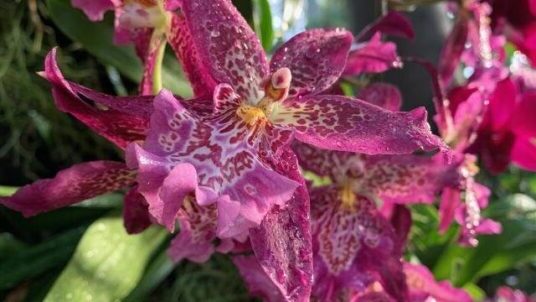Are you ready to embark on an extraordinary journey into the world of orchids? Brace yourself for a captivating exploration where you’ll uncover the secrets, beauty, and endless wonders of these enchanting flowers. From their vibrant colors and intricate patterns to their exquisite fragrances, orchids have captivated the hearts of nature enthusiasts for centuries.
So, get ready to immerse yourself in a conversation that will take you on a thrilling adventure to discover the orchids, where every page reveals something new and awe-inspiring. Let’s dive in and unravel the mysteries of these extraordinary botanical treasures together.
Discover the Orchids: A Guide to the Fascinating World of Orchid Diversity and Beauty
Orchids are among the most enchanting and diverse flowers found in nature. With their vibrant colors, intricate shapes, and captivating fragrances, orchids have fascinated humans for centuries. Whether you are a seasoned gardener, a nature enthusiast, or simply have an appreciation for the beauty of flowers, delving into the world of orchids will undoubtedly be a rewarding journey.
In this comprehensive guide, we will explore the various aspects of orchids, including their origins, types, cultivation techniques, and interesting facts. So, let’s embark on an adventure to discover the extraordinary world of orchids!
The Origins of Orchids
Orchids, belonging to the Orchidaceae family, are one of the largest and most diverse plant families on Earth. With over 28,000 recognized species and countless hybrids, they can be found in virtually every corner of the world, except Antarctica. Orchids have been around for millions of years and are believed to have evolved during the age of dinosaurs.
Interestingly, orchids have adapted to thrive in a wide range of habitats, from humid rainforests to arid deserts and even high-altitude mountains. Each orchid species has its unique set of adaptations that allow it to survive and reproduce successfully in its specific environment. These adaptations have contributed to the immense diversity and resilience of orchids.
The Astonishing Diversity of Orchids
The mesmerizing variety of orchids is truly awe-inspiring. From the small and delicate flowers of the Pleurothallid group to the flamboyant blooms of the Cattleya alliance, each orchid species has its distinct charm and characteristics. Here are some notable orchid groups:
1. Phalaenopsis Orchids
Phalaenopsis orchids, often referred to as “moth orchids,” are one of the most popular types of orchids among enthusiasts. Known for their elegant, arching sprays of flowers, Phalaenopsis orchids come in a wide array of colors, including white, pink, purple, and even spotted or striped varieties. These orchids are relatively easy to care for and are a great choice for beginners.
2. Cattleya Orchids
Cattleya orchids are famous for their large, showy blooms that exude an enchanting fragrance. These orchids often have vibrant colors and intricate patterns on their petals. Cattleyas are cherished by orchid collectors and are a favorite choice for corsages and cut flowers.
3. Dendrobium Orchids
Dendrobium orchids are known for their graceful sprays of flowers and are found in a wide range of colors. These orchids can be epiphytic, lithophytic, or terrestrial, depending on the species. Dendrobiums are highly adaptable and can be grown successfully in various climates.
4. Oncidium Orchids
Oncidium orchids, commonly called “dancing ladies,” are beloved for their vibrant colors and abundant blooms. These orchids often have small, delicate flowers that resemble dancing figures. Oncidiums are a popular choice for orchid enthusiasts due to their resilience and striking appearance.
Cultivating Orchids: Tips and Techniques
While orchids are renowned for their beauty, they have also gained a reputation for being challenging to grow. However, with the right knowledge and techniques, you can successfully cultivate orchids and witness them thrive under your care. Here are some essential tips to help you get started:
1. Light and Temperature Requirements
Orchids have varying light and temperature preferences depending on their natural habitat. Understanding these requirements is crucial for providing optimal growing conditions. Some orchids, such as Phalaenopsis, prefer bright but indirect light, while others, like Dendrobiums, thrive in bright, direct sunlight. Temperature preferences also vary, ranging from cool-growing orchids to those that prefer warmer conditions.
2. Watering and Humidity
Proper watering is fundamental for orchid care, as overwatering or underwatering can harm the plants. Most orchids prefer a moist but well-draining growing medium. It is important to allow the roots to dry slightly between waterings to prevent rot. Additionally, orchids generally appreciate higher humidity levels, which can be achieved by using a humidifier or placing the plants on trays filled with water and pebbles.
3. Potting and Repotting
Orchids have unique potting requirements due to their epiphytic nature. They often thrive in well-draining media, such as bark or sphagnum moss. Regular repotting is necessary to refresh the growing medium and provide space for the orchid’s roots to grow. The ideal time for repotting varies depending on the orchid species and its growth cycle.
4. Fertilizing
Appropriate fertilization can significantly enhance the growth and blooming of orchids. It is recommended to use a specialized orchid fertilizer diluted to half the recommended strength. Regular fertilization during the active growing season helps provide essential nutrients for healthy orchid development.
Fun Facts about Orchids
As we continue our journey through the world of orchids, let’s explore some fascinating facts that showcase the uniqueness of these extraordinary flowers:
- Orchids are found on every continent except Antarctica, demonstrating their adaptability to diverse environments.
- The smallest orchid in the world, Platystele jungermannioides, has flowers measuring only 2.1 mm wide.
- The largest orchid, Grammatophyllum speciosum, can grow up to 10 feet tall and produce over 10,000 flowers.
- Orchids have a symbiotic relationship with certain fungi, relying on them for germination and nutrient absorption.
- Vanilla, a widely used flavoring ingredient, is derived from the seed pods of orchids in the genus Vanilla.
- Some orchids have evolved unique mechanisms to attract pollinators. For example, the bucket-shaped flowers of the Bucket Orchid (Coryanthes spp.) collect rainwater to entice male bees, ensuring successful pollination.
In Conclusion
Orchids are undeniably remarkable and diverse plants that continue to captivate people of all ages. From their extraordinary range of colors, shapes, and fragrances to their unique adaptations and cultivation techniques, orchids offer endless fascination and beauty. Whether you are an aspiring orchid enthusiast or simply appreciate the splendor of nature’s creations, delving into the world of orchids will undoubtedly enrich your life. So, why not embark on this marvelous journey and discover the orchids for yourself?
Discover the miracle: An aspirin helps orchids bloom forever
Frequently Asked Questions
Frequently Asked Questions (FAQs)
What are orchids?
Orchids are flowering plants that belong to the Orchidaceae family. They are known for their vibrant and diverse blooms, which come in a wide range of colors, shapes, and sizes.
Where are orchids found?
Orchids can be found in various parts of the world, including tropical and subtropical regions. They thrive in diverse environments such as rainforests, mountainous areas, and even deserts.
How do orchids reproduce?
Orchids have unique methods of reproduction. They can reproduce both sexually through pollination and asexually through techniques like division, keiki propagation, and tissue culture.
What are the different types of orchids?
There are thousands of orchid species, each with its own distinct characteristics. Some popular types of orchids include Phalaenopsis, Cattleya, Dendrobium, Oncidium, and Vanda.
How do I care for orchids?
Orchid care varies depending on the species, but general care involves providing proper light, temperature, humidity, watering, and fertilization. It’s important to understand the specific needs of your orchid type.
Can orchids be grown indoors?
Yes, many orchids can be successfully grown indoors as long as they receive adequate light, temperature, and humidity. Certain orchid species, like Phalaenopsis, are particularly well-suited for indoor cultivation.
What should I do if my orchid doesn’t bloom?
If your orchid fails to produce blooms, it could be due to various reasons such as inadequate light, improper watering, insufficient nutrients, or even the plant’s natural growth cycle. Assess the conditions and make adjustments accordingly.
How long do orchids typically live?
The lifespan of orchids can vary greatly depending on the species and care provided. Some orchids can live for several decades, while others have a shorter lifespan. With proper care, many orchids can thrive for years.
Final Thoughts
Orchids truly captivate with their diversity and beauty. From the vibrant hues of the Cattleya to the delicate blooms of the Phalaenopsis, there is a mesmerizing orchid for every taste. Discover the orchids and immerse yourself in a world filled with enchantment and wonder. As you explore this stunning family of flowers, you’ll witness the endless variations and intricate details that make each orchid unique. Whether you’re a seasoned orchid enthusiast or a newcomer to the world of plants, exploring the realm of orchids promises a breathtaking experience. So take a moment to appreciate the elegance of these remarkable flowers and let the magic of orchids inspire you.
Auto Amazon Links: No products found.
Perfect Plants Christmas Tree Saver 8oz. | Easy Use Xmas Tree Preserver Food | Have Healthy Green Christmas Trees All Holiday Season
$9.97 (as of December 3, 2025 00:36 GMT +00:00 - More info- Product prices and availability are accurate as of the date/time indicated and are subject to change. Any price and availability information displayed on [relevant Amazon Site(s), as applicable] at the time of purchase will apply to the purchase of this product.
Kaiedos Christmas Tree Watering Funnel - 39 Inch Funnel, Reusable Design, Makes Watering Your Live Tree a Snap!
$14.99 (as of December 3, 2025 00:36 GMT +00:00 - More info- Product prices and availability are accurate as of the date/time indicated and are subject to change. Any price and availability information displayed on [relevant Amazon Site(s), as applicable] at the time of purchase will apply to the purchase of this product.
Christmas Tree Watering Funnel, Real Christmas Tree Water Long Funnel About 40 Inch, Trees Watering System for Water Indoor Outdoor
$15.99 (as of December 3, 2025 00:36 GMT +00:00 - More info- Product prices and availability are accurate as of the date/time indicated and are subject to change. Any price and availability information displayed on [relevant Amazon Site(s), as applicable] at the time of purchase will apply to the purchase of this product.
IPOOLTENG Christmas Tree Watering Funnel 3 Tube 1 Funnels 40 Inch - 3 Section Plastic Christmas Tree Funnel Waterer, Long Funnels for Watering Trees, Best Gifts for Your Parents to Water Tree
$15.53 (as of December 3, 2025 00:36 GMT +00:00 - More info- Product prices and availability are accurate as of the date/time indicated and are subject to change. Any price and availability information displayed on [relevant Amazon Site(s), as applicable] at the time of purchase will apply to the purchase of this product.
1 Pack Christmas Tree Watering Funnel System, 44 Inch Christmas Tree Watering Stick with Adjustable 3-Section Design, Reusable & Spill-Free, Xmas Plant Waterer Tool for Indoor and Outdoor
$16.99 (as of December 3, 2025 00:36 GMT +00:00 - More info- Product prices and availability are accurate as of the date/time indicated and are subject to change. Any price and availability information displayed on [relevant Amazon Site(s), as applicable] at the time of purchase will apply to the purchase of this product.
Cuisinart 6.5" Cast Iron Smashed Burger Press, Round Flat Edge Grill Press for Crispy Smash Burgers, Burger Tool for Grill and Griddle Accessories, for BBQs and Tailgates
$24.99 (as of December 3, 2025 16:48 GMT +00:00 - More info- Product prices and availability are accurate as of the date/time indicated and are subject to change. Any price and availability information displayed on [relevant Amazon Site(s), as applicable] at the time of purchase will apply to the purchase of this product.
Muddy Mat® Shown on TV Super Absorbent Microfiber Dog Door Mat for Muddy Paws, Non-Slip Washable Pet Rug, Quick Dry Chenille Entryway Carpet, Machine Washable Indoor Outdoor mat, Grey 30"x19"
$19.95 (as of December 3, 2025 16:48 GMT +00:00 - More info- Product prices and availability are accurate as of the date/time indicated and are subject to change. Any price and availability information displayed on [relevant Amazon Site(s), as applicable] at the time of purchase will apply to the purchase of this product.
Snow Joe Premium Enviro Blend Ice Melt, Green-Coated Deicer Crystals, 50 lb - Safer Melter for Vegetation, Concrete & Metals w/ Anti-Corrosion Calcium Magnesium Acetate
$32.97 (as of December 3, 2025 16:48 GMT +00:00 - More info- Product prices and availability are accurate as of the date/time indicated and are subject to change. Any price and availability information displayed on [relevant Amazon Site(s), as applicable] at the time of purchase will apply to the purchase of this product.
OLANLY Dog Door Mat for Muddy Paws 30x20, Absorbs Moisture and Dirt, Absorbent Non-Slip Washable Doormat, Quick Dry Chenille Mud Mat for Dogs, Entry Indoor Entryway Carpet for Inside Floor, Grey
$9.99 (as of December 3, 2025 16:48 GMT +00:00 - More info- Product prices and availability are accurate as of the date/time indicated and are subject to change. Any price and availability information displayed on [relevant Amazon Site(s), as applicable] at the time of purchase will apply to the purchase of this product.
Zevo Flying Insect Trap Official Refill Cartridges - Fits Both Zevo Trap & MAX Indoor Fly Trap - Authentic Trap+Lock Technology to Catch Gnats, House & Fruit Flys (4 Official Refill Cartridges)
$14.97 (as of December 3, 2025 16:48 GMT +00:00 - More info- Product prices and availability are accurate as of the date/time indicated and are subject to change. Any price and availability information displayed on [relevant Amazon Site(s), as applicable] at the time of purchase will apply to the purchase of this product.











